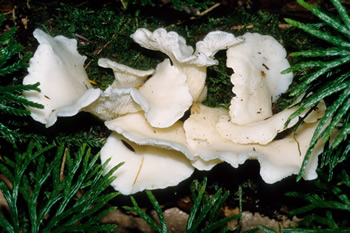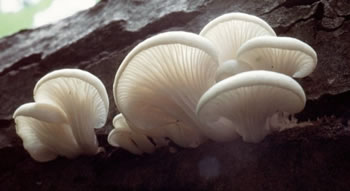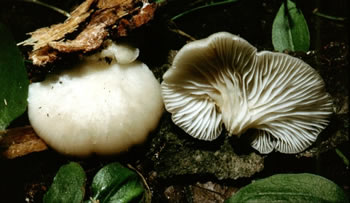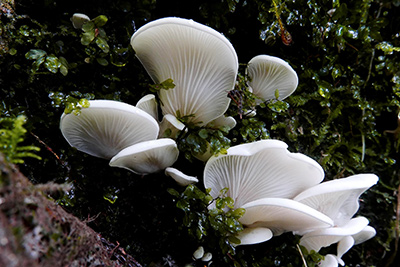Pleurocybella porrigens
Scientific name: Pleurocybella porrigens
(Pers.)
Singer
Derivation of name: Porrigens means "extending
forward, projecting horizontally."
Synonyms: Pleurotus porrigens (Pers.) P. Kumm.
Common name(s): Angel's wings.
Phylum: Basidiomycota
Order: Agaricales
Family: Marasmiaceae
Occurrence on wood substrate: Saprobic; solitary to
clustered on dead conifer logs and stumps, particularly
eastern hemlock (Tsuga canadensis); August through
October.
Dimensions: Caps 2.5-10 cm wide.
Cap: Smooth; white; flesh very thin.
Gills: White; crowded and narrow; decurrent; radiating
from stub-like
point of attachment.
Spore print: White.
Stipe: Absent or present as a narrowed, stubby, white
base.
Veil: Absent.
Edibility: Caution. Although there are no reports from
Europe or North America, several elderly patients with
underlying kidney disease were poisoned in Japan. Until
a number of questions are answered, it's probably
best
to avoid eating this species.
Comments: Pleurotus ostreatus and related oyster
mushrooms, while resembling Pleurocybella porrigens,
are much more robust species with thicker flesh and
they almost always occur on deciduous wood.

Figure 1.
Angel's wings. Photo © John Plischke III.

Figure 2. The thin flesh of Angel's wings is readily
apparent in this photograph. Photo © Steve Nelsen.

Figure 3. Pleurocybella porrigens. The gills are
decurrent and radiate from the narrowed, stub-like base.
Photo © Steve Nelsen.

Figure 4. An award-winning photograph of angel's wings,
capturing the delicate structure and beauty of this species.
Photo © Steve Ness.